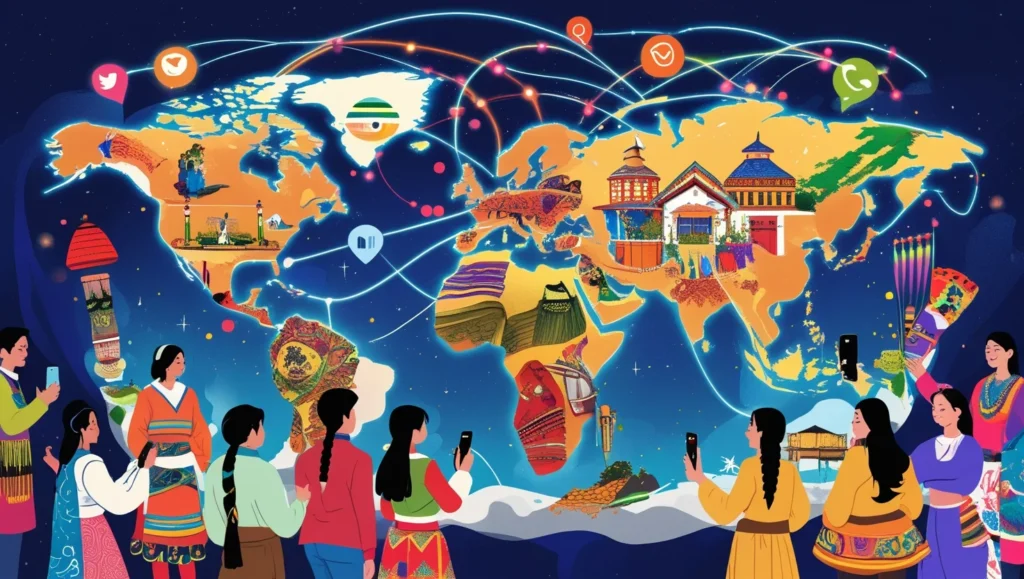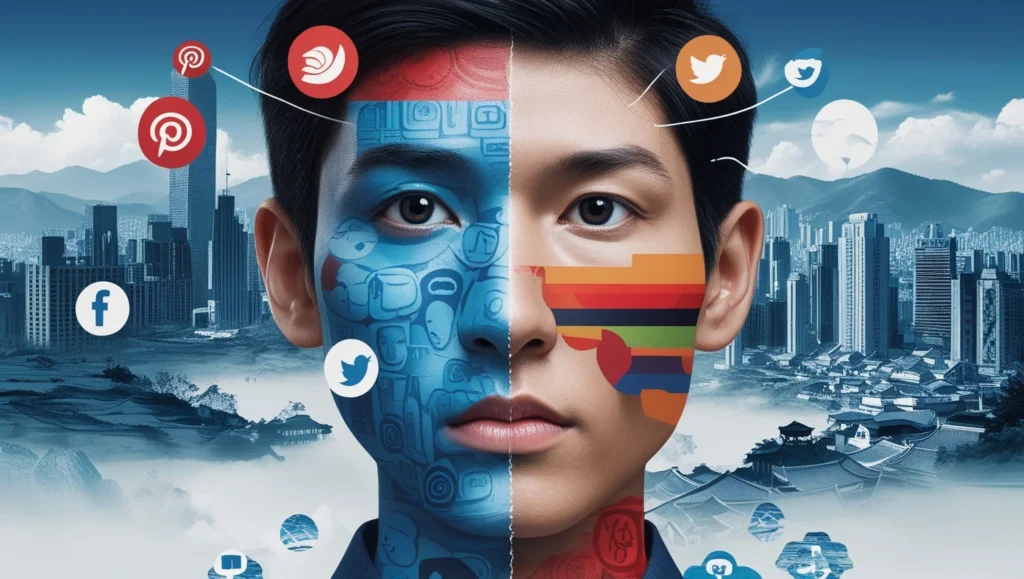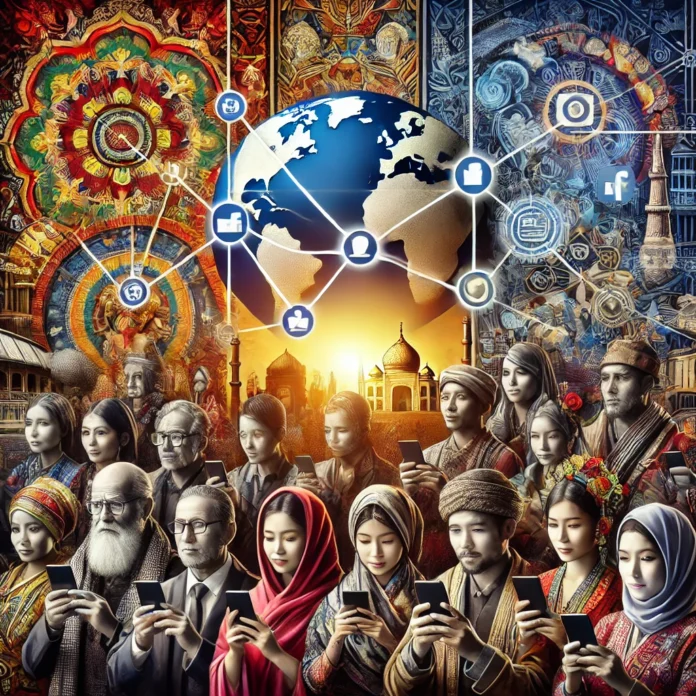Introduction
In an era dominated by digital connectivity, social media has revolutionized how individuals interact, share ideas, and perceive their cultural identity. These platforms have become a powerful medium for cultural expression, allowing users to celebrate, learn, and engage with different traditions and customs. However, social media also raises concerns about homogenization, misinformation, and cultural appropriation. The rapid spread of digital content has blurred traditional cultural boundaries, creating a dynamic where identities are constantly reshaped by external influences.
Cultural identity is a complex construct influenced by history, language, customs, and shared values. Social media plays a dual role in this equation—it can either strengthen cultural ties by fostering engagement and awareness or weaken them by eroding traditional practices. This article explores the multifaceted impact of social media on cultural identity, analyzing both its benefits and challenges while offering strategies for preserving cultural heritage in the digital landscape.
The Role of Social Media in Cultural Preservation

- Facilitating Cross-Cultural Exchange – Social media platforms enable people from diverse backgrounds to share and learn about different cultures, fostering understanding and appreciation. Through videos, posts, and live interactions, individuals can engage in meaningful discussions about traditions, rituals, and historical events, bridging cultural gaps and fostering global unity. This exchange allows individuals to become more culturally literate and appreciative of differences, reducing prejudices and stereotypes. Additionally, social media facilitates cross-cultural collaboration in arts, music, and business, contributing to a richer, more interconnected world. The ability to instantly communicate across continents enables real-time cultural dialogue and appreciation.
- Digitization of Cultural Heritage – Museums, cultural organizations, and individuals use social media to archive and promote cultural traditions, folklore, and historical artifacts. Many institutions now host virtual exhibitions and educational livestreams, allowing audiences worldwide to experience cultural heritage without geographical barriers. This digital preservation ensures that even remote or endangered traditions remain accessible to future generations. The creation of online databases and digital libraries allows for extensive documentation of oral histories, traditional music, and native crafts, preserving them in ways that previous generations never had access to. Additionally, the use of augmented reality (AR) and virtual reality (VR) in online exhibits has made cultural learning more immersive and interactive.
- Empowering Indigenous Voices – Marginalized and indigenous communities utilize social media to share their narratives, traditions, and struggles, helping preserve their cultural heritage. By providing a platform to highlight their perspectives, social media ensures that these voices are not lost in mainstream narratives. Activism and advocacy through social media have led to policy changes, increased visibility, and the safeguarding of indigenous rights. Many indigenous content creators use social media to educate others about their customs, languages, and histories, strengthening a sense of pride and belonging within their communities. Additionally, digital storytelling through blogs and video content allows indigenous communities to reclaim their histories, challenge misrepresentations, and celebrate their identity on a global scale.
- Revitalization of Endangered Languages – Platforms like YouTube and TikTok serve as mediums for teaching and spreading endangered languages, ensuring their survival. Language-learning content, interactive lessons, and cultural storytelling help keep linguistic diversity alive for future generations. Social media campaigns such as #SpeakYourLanguage encourage individuals to practice and share their native tongues online. Additionally, AI-driven translation tools and voice recognition technology have facilitated greater accessibility for non-mainstream languages, allowing them to be used in digital communication and education. Online language exchange communities help connect speakers of endangered languages with learners, ensuring continuous engagement and preservation.
- Promoting Traditional Practices – Influencers and communities leverage social media to showcase and encourage participation in traditional arts, crafts, music, and rituals. Online challenges, festivals, and live demonstrations allow people to engage with and learn from authentic cultural practitioners. This digital revival of traditions fosters a renewed interest in cultural heritage among younger generations. More people are now participating in virtual cultural workshops, online folk music performances, and digital storytelling sessions, creating a hybrid space where the past meets the present. Through social media, cultural organizations are organizing global competitions and interactive workshops to help spread awareness and appreciation for traditional skills, ensuring they remain relevant in contemporary society.
The Challenges Posed by Social Media on Cultural Identity

- Cultural Homogenization – The dominance of globalized trends can overshadow and dilute local customs and traditions, leading to cultural erosion. The widespread adoption of Westernized fashion, entertainment, and lifestyle choices often marginalizes indigenous and traditional practices. This cultural uniformity may lead to the loss of unique customs that once defined specific ethnic or regional identities. In some cases, individuals may feel pressured to conform to the dominant online culture, leading to the gradual disappearance of authentic traditions.
- Misinformation and Stereotypes – Social media can perpetuate false narratives, stereotypes, and cultural misrepresentations, affecting societal perceptions. Misleading content and inaccurate portrayals can contribute to cultural misunderstandings and reinforce biases. The spread of misinformation about certain customs can lead to cultural appropriation or even discrimination against particular groups. The viral nature of online content means that myths and inaccuracies can spread rapidly, creating long-lasting distortions about various cultures.
- Commercialization of Culture – Traditional practices and symbols are often commodified without context, leading to cultural appropriation rather than appreciation. Fashion, music, and art inspired by cultural symbols are sometimes used for profit without acknowledging their origins. The commercialization of sacred traditions for entertainment or commercial gain can diminish their original significance. Brands and influencers sometimes exploit cultural elements for marketing purposes, reducing meaningful traditions to mere aesthetic trends.
- Loss of Deep Cultural Engagement – The fast-paced nature of social media often promotes superficial engagement with cultural content, reducing deep-rooted connections. Memes and viral trends may trivialize meaningful traditions, making them seem like mere entertainment rather than valuable heritage. This surface-level interaction fails to instill a genuine appreciation or understanding of a culture’s complexity. Many younger users consume cultural content passively, without actively engaging in learning about the history or significance behind it.
- Generational Divide – Older generations may struggle to adapt to digital platforms, creating gaps in cultural transmission between generations. Without direct interactions, younger audiences may not receive the full depth of cultural teachings and practices from their elders. This disconnect can lead to the fading of oral traditions, customary practices, and ancestral knowledge. Social media’s preference for short-form content makes it difficult to convey long-standing traditions in meaningful ways that require more context and depth.
How Social Media Reshapes Personal and Community Identity

Shaping Personal Identity
Social media serves as a dynamic platform for individuals to craft, express, and refine their personal identities. Through curated online personas, users project aspects of their personalities, lifestyles, and cultural affiliations, influencing their self-perception and how they are perceived by others. The ability to experiment with different facets of identity enables people to explore their heritage, traditions, and values in ways that were not previously possible.
Platforms like Instagram, TikTok, and YouTube empower users to showcase their cultural roots through fashion, language, art, and daily practices. However, this digital self-representation can sometimes lead to identity struggles, particularly when online expectations clash with deeply ingrained traditional norms. The pressure to conform to trending digital cultures—such as viral beauty standards, lifestyle choices, or ideological movements—can challenge personal and familial values, leading to internal conflicts.
Moreover, the influence of algorithm-driven content consumption means that individuals are often exposed to curated realities that may not align with their authentic selves. This can result in social comparison, identity fragmentation, or the adoption of superficial aspects of various cultures without a deep understanding of their significance.
Community Building and Belonging
Social media plays a crucial role in fostering community ties, helping individuals connect with like-minded people across the globe. The formation of niche cultural communities enables members to share their experiences, celebrate traditions, and support one another, despite geographical distances.
For diaspora communities, digital platforms serve as lifelines that preserve cultural identity and heritage. Facebook groups, WhatsApp forums, and Reddit threads provide safe spaces where individuals can discuss cultural traditions, language, and values. For instance, African, Indian, and Latin American diaspora communities often use social media to celebrate traditional festivals, share cultural recipes, and offer advice on navigating dual identities.
Additionally, online forums and advocacy campaigns strengthen cultural pride and unity. Hashtags such as #RepresentationMatters and #ProudToBe help amplify voices that may be underrepresented in mainstream media, fostering a collective sense of belonging and validation.
Cultural Adaptation and Hybridization
The digital age has accelerated cultural exchange, leading to the blending and hybridization of traditions, customs, and artistic expressions. Social media acts as a catalyst for cross-cultural interactions, allowing people to engage with and adopt elements of different cultures.
From fusion cuisines (such as Korean tacos or sushi burritos) to multicultural fashion trends, social media has played an integral role in shaping new cultural identities. Platforms like Pinterest and Instagram showcase the blending of traditional attire with modern aesthetics, while TikTok popularizes diverse music and dance influences that transcend borders.
While cultural fusion fosters creativity and global appreciation, it also raises concerns about cultural dilution and appropriation. Some traditions risk being commodified or misrepresented when adopted without proper understanding or respect. Digital spaces must encourage ethical cultural exchange by prioritizing education, acknowledgment, and responsible representation.
Influence of Digital Influencers
Social media influencers wield immense power in shaping cultural norms, values, and trends. Online personalities influence public perceptions of fashion, beauty, language, and lifestyle choices, often dictating what is considered desirable or mainstream.
For instance, influencers who embrace and promote traditional garments, indigenous crafts, or regional dialects contribute to the preservation and popularization of cultural heritage. However, there is also a risk of cultural distortion when elements are commercialized without context or authenticity. The rapid spread of trends through influencer-driven content can sometimes lead to the oversimplification of complex cultural narratives, reinforcing stereotypes rather than fostering genuine appreciation.
It is crucial for influencers to collaborate with cultural experts, historians, and community leaders to ensure accurate and ethical representation. By doing so, they can use their platforms to educate their audiences and promote cultural appreciation rather than mere commodification.
Activism and Cultural Identity
Social media serves as a powerful tool for cultural advocacy and activism. Online movements have given marginalized communities a platform to reclaim their narratives, challenge systemic biases, and raise awareness about cultural and social justice issues.
Hashtags such as #BlackExcellence, #IndigenousRights, and #StopAsianHate have played instrumental roles in mobilizing support for cultural and racial equity. These campaigns have influenced policy discussions, improved representation in mainstream media, and fostered global solidarity around cultural issues.
Through social media, cultural activists can share historical knowledge, debunk misconceptions, and inspire meaningful conversations about identity and heritage. Online petitions, crowdfunding campaigns, and digital storytelling initiatives further amplify the voices of underrepresented communities, ensuring that cultural narratives are preserved and celebrated.
Strategies for Maintaining Cultural Identity in the Digital Age

Creating Educational Content
Promoting culturally rich, educational content on social media helps spread awareness and sustain traditions. Content creators, historians, and educational institutions can collaborate to produce documentaries, explainer videos, and interactive lessons that highlight cultural knowledge. Platforms such as YouTube and Instagram Reels are particularly effective for sharing bite-sized yet impactful educational content.
By making information accessible and engaging, digital education fosters appreciation and understanding across diverse audiences. Museums and heritage organizations can also utilize social media to showcase cultural artifacts and historical narratives, bridging the gap between tradition and modernity.
Encouraging Digital Storytelling
Digital storytelling is a powerful method of preserving and sharing cultural heritage. Individuals and communities can use blogs, vlogs, podcasts, and social media platforms to document oral histories, family traditions, and folklore.
For instance, indigenous communities have leveraged digital media to preserve endangered languages, while elders from various cultures use online platforms to share wisdom and ancestral knowledge. This approach ensures that cultural legacies are passed down to future generations while making them more accessible to global audiences.
Supporting Ethical Representation
Advocating for accurate and respectful portrayals of cultures in digital spaces helps prevent misrepresentation. Content creators, brands, and media platforms should prioritize collaboration with cultural experts to ensure authenticity in storytelling.
Ethical representation also involves addressing cultural appropriation and ensuring that cultural contributions are credited to their rightful origins. By promoting responsible content creation, digital platforms can play a vital role in preserving cultural integrity.
Engaging Youth in Cultural Preservation
Involving younger generations in cultural preservation is essential for maintaining traditions in the digital era. Social media challenges, interactive educational programs, and digital storytelling initiatives can make cultural learning more engaging for youth.
Platforms like TikTok and Instagram have been instrumental in introducing younger audiences to traditional dances, languages, and customs. Encouraging young individuals to become cultural ambassadors fosters a sense of pride and responsibility in preserving their heritage.
Leveraging Technology for Cultural Documentation
Emerging technologies such as virtual reality (VR) and augmented reality (AR) offer innovative ways to document and experience cultural heritage. Virtual museum tours, interactive heritage sites, and immersive digital exhibitions bring history to life, making it accessible to global audiences.
By integrating technology into cultural education and preservation efforts, communities can ensure that their traditions remain relevant and accessible in the digital age. These advancements help bridge generational gaps, providing new ways for individuals to engage with their heritage in meaningful ways.
Conclusion
Social media is a double-edged sword in shaping cultural identity. While it offers opportunities for cultural expression, preservation, and global awareness, it also presents challenges such as homogenization and misrepresentation. Striking a balance between embracing digital connectivity and preserving cultural authenticity is crucial in the ever-evolving social media landscape. By fostering responsible online engagement and supporting authentic cultural narratives, individuals and communities can ensure that social media serves as a tool for cultural enrichment rather than erosion.


